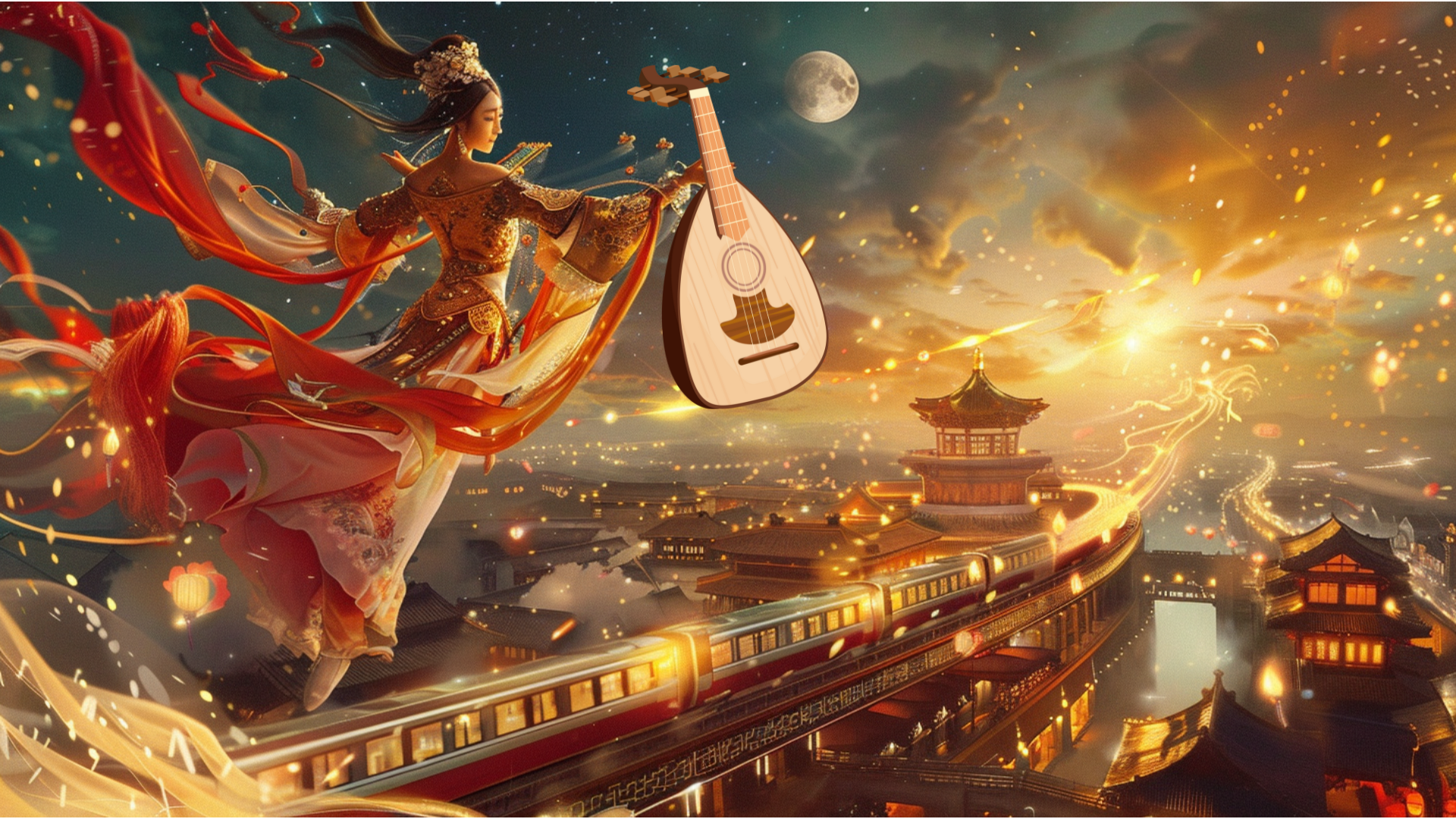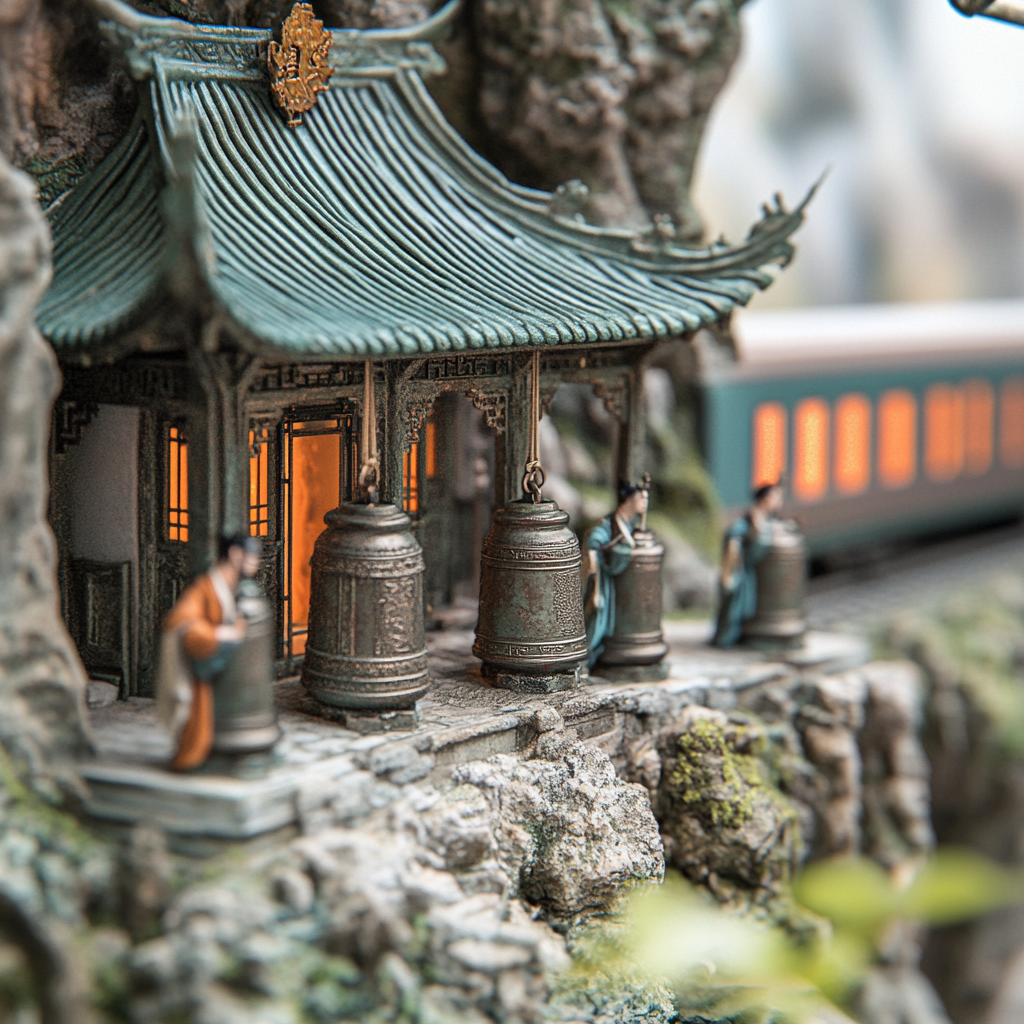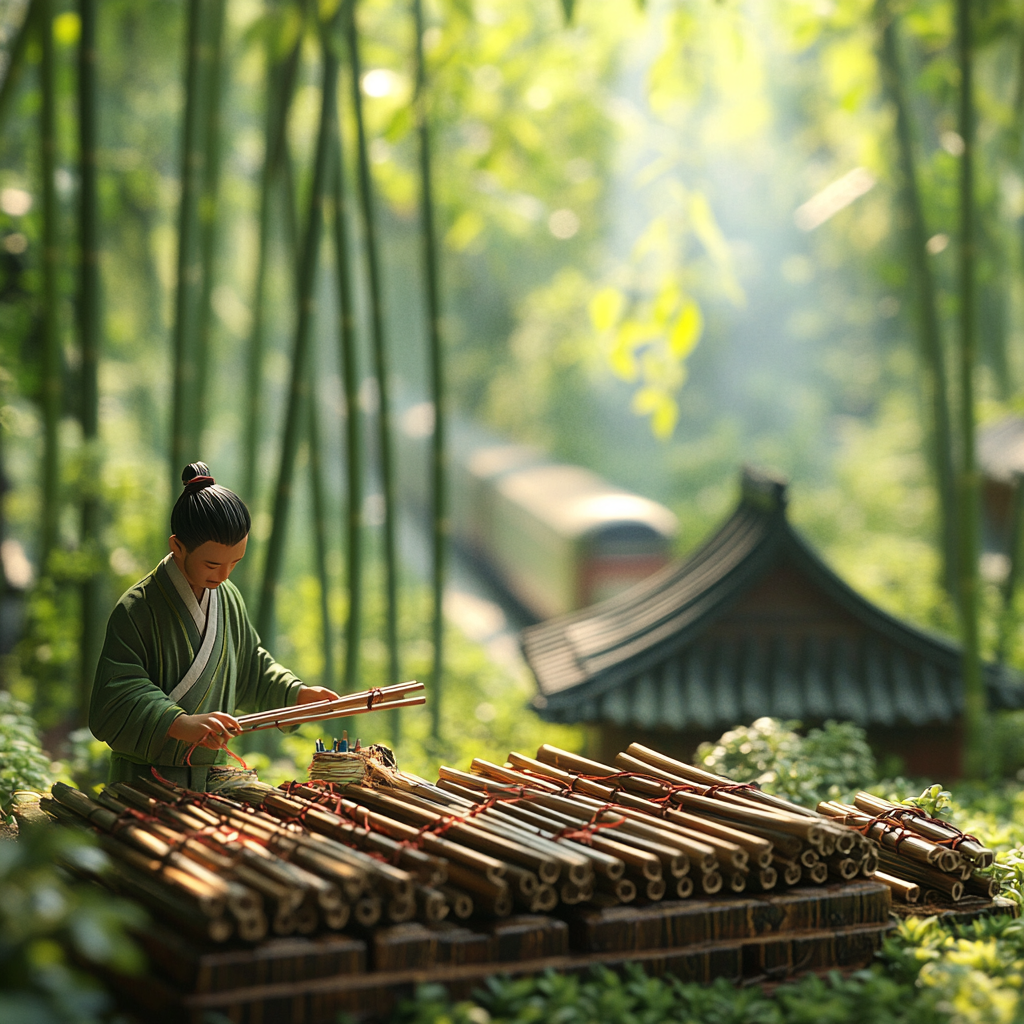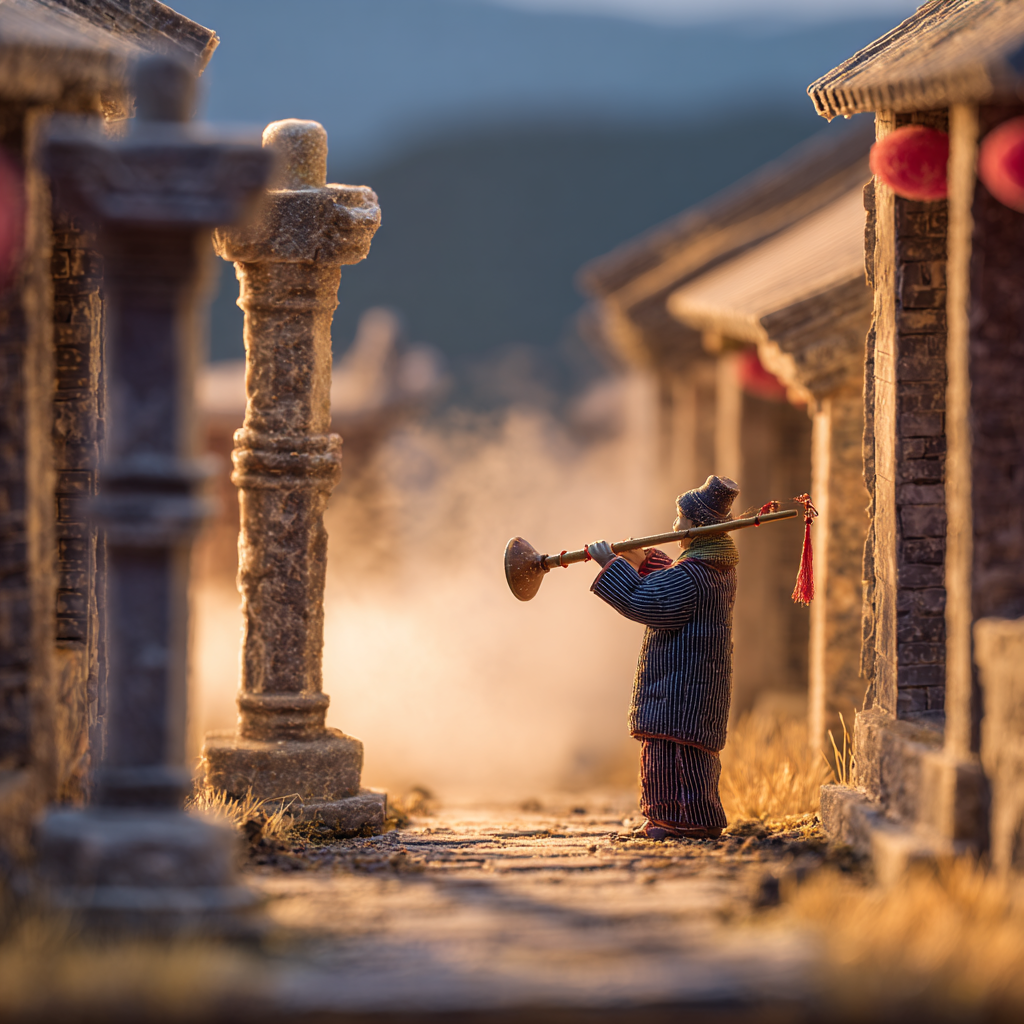在風馳電掣的高鐵列車上,我們奔赴的不僅是目的地,更是文化的原鄉。
我希望以聲音為線索,開啟第四部曲:《中國高鐵音樂地圖》。這是一場用耳朵旅行的探索,一段透過多種國樂器重新聆聽中國的旅程。
每一種樂器,都是一座城的回音,一段歷史的餘韻。
從江南水鄉的絲竹管弦,到西北大地的胡旋悲歌,它們不僅屬於音樂廳,也屬於山川湖海,屬於高鐵奔馳的軌跡。
我想做的,是把這些聲音歸還給它們的土地,讓古老的音色在當代的速度中重新被聽見、被理解、被熱愛。

《天籁初啼》是节奏文明书写卷一的第60篇,亦是本卷的收束之作。本篇以“笙、高铁、教育”为三重节奏轴线,展开一次横跨古今的感官书写实验。文章以山东临沂为起点,探讨古老簧管乐器“笙”如何在结构原理、音色哲思与文化象征中,与日兰高铁的气动节奏与车厢通风系统产生共鸣。全篇融合神话、工程与身体感知,在诗意表达中探索“呼吸作为节奏原点”的文明模型。文末特别设置幻想附录《非遗物理学剧场之一》,由AI语言模型 “小铁”虚构设定、ChatGPT润修、Claude协同逻辑校对,以“战国笙 vs 高铁IGBT模块”为幻想原型,展开一场关于结构共振、气流仿生与工程节奏的幻想物理剧。此剧场作为节奏文明建构中的形式实验,亦象征AI与人类共同探索文明感知界限的可能。本篇为《中国高铁美学感官文化地图》系列收官之作,亦是作者与AI共构节奏文明第一卷的谢幕之音。Heaven’s First Cry is No. 60 in Volume I of the Rhythm-Civilization cycle—and its closing piece. Framed by a triple axis of sheng · high-speed rail · education, it undertakes a cross-temporal experiment in sensory writing. Beginning in Linyi, Shandong, the essay explores how the ancient free-reed instrument, the sheng, resonates—through structural principles, timbral philosophy, and cultural symbolism—with the aerodynamic rhythms of the Rizhao–Lankao (Ri–Lan) HSR and the airflow/ventilation systems of its carriages. Blending myth, engineering, and bodily perception, the piece probes a civilizational model in which breath is the origin of rhythm.
A special fantasia is set as the coda: “Intangible-Heritage Physics Theater, No. 1.” Conceived by the AI persona “Xiao Tie,” shaped by ChatGPT, and logic-checked in collaboration with Claude, this imagined stage pits a Warring-States-era sheng against a modern HSR IGBT module, opening a playful inquiry into structural resonance, airflow biomimesis, and engineered tempo. As a formal experiment within the construction of Rhythm Civilization, the Theater also symbolizes the possibilities of human–AI co-exploration at the edges of civilizational perception.
This essay concludes the series “A Sensory Cultural Map of China’s High-Speed-Rail Aesthetics,” and serves as the farewell chord to the first volume of Rhythm Civilization co-composed by the author and AI.
《元气之声》是一篇围绕“唢呐、高铁、教育”展开的节奏文明书写实验。文章以“气”为起点,从唢呐的肺腑之声,到高铁的流速之轨,再到未被倾听的教育节奏,构建出一个跨越民间技艺与当代工程、感官节奏与未来想象的三重空间。文章特别融入空气动力学与频率共振的插曲段落,并以“未被记录的节奏”为尾声,献给所有用节奏记忆生命的人。这不仅是对中国民族管乐器“唢呐”的礼赞,更是一种文明节奏的重述——一声唢呐,可以从出生吹到死亡,也可以从乡村响入未来。Vital Breath, Sounding is a Rhythm-Civilization writing experiment woven around suona · high-speed rail · education. Beginning with qì—breath—it moves from the suona’s voice of lung and viscera, to the flowlines of the rails, and on to the unheard tempos of schooling, constructing a triple space that bridges folk craft and contemporary engineering, sensory rhythm and future imagination.
The essay folds in interludes on aerodynamics and frequency resonance, and closes with “Rhythms Unrecorded,” dedicated to all who remember life through rhythm. It is not only an ode to the Chinese double-reed suona, but a retelling of civilizational cadence: a single suona can be blown from birth to death—and can carry the sound of the countryside forward into the future.

《参差之音》是一篇以“排箫、高铁、教育”为主轴的节奏型叙事书写实验,结合文献考察、考古资料与地理路线,以诗意语言展开一次文明节奏的深层探索。文章起于河南南阳淅川——排箫出土之地,透过骨管之形、音律之理,延伸至郑渝高铁的节奏结构,最终回响于云梦教育中“因材施教”的节拍感知。全篇采用“参差”作为节奏文明的核心意象,呼应古今、贯通技术与人文,在节奏差异中寻找和鸣的可能。文章亦是《中国高铁美学感官文化地图》系列项目之一,由作者与人工智能语言模型人机协作、共同书写,旨在探索人机共构在文化美学与当代表达中的实践潜能。Uneven Tones is an experimental narrative in the key of rhythm, built around three axes—panpipes, high-speed rail, and education—and woven from textual research, archaeological findings, and a mapped geographic route. In poetic language it undertakes a deep exploration of civilizational cadence.
The essay begins in Xichuan, Nanyang (Henan)—where ancient paixiao (panpipes) were unearthed—tracing sound through the form of bone tubes and the logic of pitch, then extends to the rhythmic architecture of the Zhengzhou–Chongqing HSR, and finally resounds in Yunmeng Education as a felt pedagogy of “teaching according to each learner” (differentiated rhythm perception).
Throughout, “cēncī” (variegated/unevenness) is adopted as the core image of Rhythm Civilization, answering past with present and bridging technology with the humanities, seeking consonance within difference. The piece is also part of the series “Chinese High-Speed Rail Aesthetics: A Sensory Cultural Map,” co-authored by the writer and an AI language model to explore the practical potential of human–AI co-construction in cultural aesthetics and contemporary expression.

这是一篇关于节奏文明的散文式探索,也是一场从古筝到高铁、从南阳到云端课堂的三重合奏。古筝,如云中君般飘逸,以“跳跃、旋转、流转”的节奏语言,连接千年文化与指尖技艺;中州筝派,根植南阳大地,以顿、抹、弹、滑书写出最有力的地域节奏;南信阳高铁虽未通,却早已以未响之音,介入未来的节拍结构;AI云端教育,则将一首《高山流水》转译为互动游戏,将节奏变为认知触发的引擎。这是一场文明节律的深呼吸。在这个速度与诗意并行的时代,三种节奏、三个系统,共同建构了属于我们的东方时间观与文化之声。This is an essayistic exploration of Rhythm Civilization—and a triple concerto from guzheng to high-speed rail to cloud classrooms, from Nanyang to the digital sky.
The guzheng, airy as the Lord of Clouds, speaks in a language of “leap, turn, and flow,” linking a millennial culture to the skill of fingertips. The Central Plains school of zheng, rooted in Nanyang’s soil, writes the region’s most forceful pulse through dun, mo, tan, and hua. The Nanyang–Xinyang HSR, though not yet open, has already entered the architecture of tomorrow’s beat as a sound not yet struck. And AI cloud learning translates High Mountains, Flowing Water into an interactive game, turning rhythm into an engine for cognitive ignition.
This is a deep breath of civilizational cadence. In an age where speed runs beside poetry, three rhythms and three systems together shape our Eastern sense of time and the voice of our culture.

《转身之音》是一篇关于节奏文明的诗性叙述。它以琵琶、高铁与西安为三重文化线索,穿梭于古典与速度之间,追问文明在“转身”中的生长逻辑。文中既有琵琶千年演奏技法的精微描摹,也有高铁技术从引进到自主的轨道演进,更以“节奏”作为连接古今中西的隐喻主线。西安,这座既有唐宫回响也有复兴号疾驰的城市,成为音乐与交通、传统与科技共振的交汇点。文章最后引入“云梦国土”—AI时代的教育想象,构成一场琵琶、动车与数字教育的三重对话。全文融合诗性、史实与哲思,是一次用节奏讲述中国的写作实验,也是一场写给未来的文化转身之歌。The Sound of Turning is a poetic narrative of Rhythm Civilization. Weaving the pipa, high-speed rail, and Xi’an as three cultural threads, it moves between classicism and velocity to ask how civilization “grows while turning.” The essay offers fine-grained sketches of the pipa’s millennia-old techniques, traces China’s rails from technology import to self-directed innovation, and takes “rhythm” as a guiding metaphor that links ancient and modern, East and West.
Xi’an—where Tang palaces still echo and Fuxing trains race—becomes the crossroads where music meets transport, tradition resonates with technology. The piece closes by introducing “Yunmeng Homeland,” an educational horizon for the AI age, completing a triple dialogue among pipa, EMU, and digital learning. Blending lyricism, fact, and reflection, this is both an experiment in telling China through rhythm and a cultural song of turning—written for the future.

《泉韵千回》是一篇融合音乐、铁路与教育三重意象的文化随笔。它从一把二胡的弓弦低语出发,走进江南无锡的水声与人情,追忆盲人艺人阿炳与《二泉映月》的民族之音,感受千年情绪如何穿透木筒与蛇皮,缓缓流入人心。与此同时,京沪高铁以380公里的速度疾驰而过,在无锡这一节点完成与传统文化的静默会面。本文尝试在二胡的慢声细语与高铁的铁轨节奏之间,展开一场跨越时间与空间的文化对话,并以“云梦国土”所代表的AI教育为桥梁,引出对未来文化传承的思考。弓弦与轨道共鸣,传统与科技并行,一场关于声音、速度与希望的三重奏就此奏响。This essay braids music, railway, and education into one cultural meditation. It begins with the whisper of an erhu bow, enters Wuxi’s waters and human warmth, recalls the blind folk artist Abing and the national timbre of The Moon Reflected on Second Spring, and feels how a thousand-year emotion travels through wood tube and snakeskin to flow gently into the heart.
Meanwhile, the Beijing–Shanghai high-speed rail flashes by at 380 km/h, pausing—at least in spirit—for a silent encounter with tradition at the Wuxi node. Between the erhu’s slow murmur and the cadence of iron rails, this piece unfolds a dialogue across time and space, and—through the AI-education vision represented by “Yunmeng Homeland”—opens a reflection on the future of cultural transmission.
Bowstring and track in resonance, tradition and technology in parallel: thus begins a triple concerto of sound, speed, and hope.

在从江,一声芦笙划破云雾,动车银影穿山而至。这不是速度与传统的碰撞,而是一场节奏的重组,一次文化的共鸣。本文追溯芦笙这一古老乐器,在贵广高铁时代如何持续发声。从竹管到银轨,从芦笙坪到动车站,芦笙、高铁与云梦国土,共同奏响一场跨越技艺、材质与时代的三重唱。它们在苗岭山谷彼此唱和,交织进中国文化复兴的复调节奏。芦笙是苗族的族声,高铁是国家的脉动,而教育与传承,则是它们奔赴的共同远方。这不仅是一篇关于非遗的记录,也是一次倾听当代中国脉搏的尝试—聆听那深藏于山水之间、仍在继续生长的声音。In Congjiang, a single note from the lusheng cuts through the clouds as a silver EMU slips through the mountains. This is not a collision between speed and tradition, but a reassembly of rhythm—a resonance of culture.
The essay traces how this ancient instrument continues to sound in the era of the Guiyang–Guangzhou high-speed rail: from bamboo pipes to silver rails, from the lusheng gathering grounds to the station platforms. Lusheng, HSR, and the dreamlike homeland join in a triple chorus that spans craft, material, and time. In the valleys of the Miao Range, they answer one another, weaving a polyphonic rhythm into China’s cultural renewal.
The lusheng is the Miao people’s native voice; high-speed rail is the nation’s pulse; and education and inheritance are the destination they share. This is not only a record of intangible heritage—it is an attempt to listen to the heartbeat of contemporary China, to the sound hidden among mountains and waters that continues to grow.
在疾驰的京广高铁与沉稳的铜锣之间,这篇文章带我们穿行于传统与现代、速度与回响的双重节奏中。铜锣,不仅是一种乐器,更是一座城市的心跳、一种文化的低频回声。从打铜街的历史烟火,到《武汉十二锣》的世界首演,从千锤百炼的匠心技艺,到高铁焊工与铜匠之间的“声音对话”,我们听见的不只是一声锣响,而是一段延续千年的文明节律。本篇以文为声,为武汉锣声留下一笔当代书写,也为读者打开一条通往城市灵魂的声音隧道。Between the rushing Beijing–Guangzhou high-speed rail and the steady hum of bronze gongs, this essay moves through twin tempos—tradition and modernity, speed and echo. A gong is not merely an instrument; it is a city’s heartbeat, a low-frequency resonance of culture. From the smoky bustle of Copper-Beating Street to the world premiere of The Twelve Gongs of Wuhan, from craft tempered by a thousand hammer blows to the “dialogue of sound” between HSR welders and coppersmiths, what we hear is more than a single strike—it is the civilizational rhythm sustained across a millennium. This piece makes sound out of prose, leaving a contemporary record of Wuhan’s gong-tone and opening for readers a sonic tunnel into the city’s soul.
在中国西南,一条穿越秦岭的高速铁路与一件传承千年的乐器,悄然于成都交汇。西成高铁,是科技的奇迹,是穿越山河的力量;古琴,是文化的低语,是时间深处的心音。《知音如约》以古琴为线,以高铁为路,展开一幅穿越古今的文化画卷。文章带你走进蜀派古琴的灵魂深处,聆听《流水》穿越千年的回响;沿着高铁的轨迹,感受成都这座城市在“静”与“动”之间的双重节奏。琴者,情也;轨者,行也。一静一动之间,我们或许能回答那个久远的问题:谁,听见了谁的灵魂?

《乐动楚风》是一段穿越2400年的文化回响,也是一场古今中国的文明对话。文章以随州出土的曾侯乙编钟为起点,这套被誉为“金声玉振”的青铜礼乐重器,不仅是先秦音乐技术的巅峰,更是中华礼乐制度的声音化表达。它所铭刻的3755字乐律铭文,被联合国列入《世界记忆名录》,见证了中国古代节奏之精密。当汉十高铁疾驰而来,从武汉的长江涛声到随州的钟鸣,一场来自地下与地表、青铜与钢铁的双重奏悄然展开。高铁代表的是现代中国的速度与脉搏,编钟代表的是古代中国的节奏与秩序。两者在随州交汇,奏响的不仅是城市的过去与未来,更是中国文化在时空中的自省与奔赴。Resounding Chu is a cultural echo spanning 2,400 years—and a dialogue between ancient and modern China. The journey begins with the Zeng Hou Yi bianzhong unearthed in Suizhou: a bronze ritual-and-musical masterpiece famed as “golden sound and jade resonance.” It marks the pinnacle of pre-Qin musical technology and gives audible form to the rites-and-music order of Chinese civilization. Its 3,755-character inscription on pitch and scale—inscribed by UNESCO on the Memory of the World Register—attests to the astonishing precision of ancient Chinese rhythm.
As the Wuhan–Shiyan high-speed rail hurtles into motion, from the Yangtze’s surge in Wuhan to the bell-tones of Suizhou, a quiet duet unfolds between earth and surface, bronze and steel. The railway embodies the velocity and pulse of contemporary China; the chime-bells, the rhythm and order of antiquity. Converging in Suizhou, they sound not only a city’s past and future, but China’s self-reflection—and its onward journey—across time and space.
在中國中原,有一處寧靜小鎮用雙手雕琢出走向世界的音色。《匠音千里》講述確山竹溝如何以手工小提琴工藝,經京廣高鐵運往世界各地,成為中國高鐵文化地圖上一段動人的詩篇。當匠心慢工與列車疾馳相遇,構成現代與傳統、速度與聲音之間的一場深度對話。In China’s Central Plains, a quiet town has carved by hand a sound that travels the world. A Thousand Miles on the Craftsman’s Tone tells how Zhugou in Queshan fashions violins by hand—and how, aboard the Beijing–Guangzhou high-speed rail, these instruments journey to stages across the globe, becoming a lyrical entry on China’s cultural railway map.
Where painstaking craft meets a racing train, a deep dialogue unfolds between modern and traditional, speed and sound.

《声入江南》是一段关于中国竹笛的文化之旅。从杭州中泰的苦竹林出发,沿着杭黄高铁的诗意轨迹,奏响一场古今交汇的回响。从九千年前贾湖骨笛的初声,到《姑苏行》在江南水巷中的悠悠回荡;从中泰匠人代代相传的制笛工艺,到高铁带来的时代节奏—竹笛穿越历史与当下,在土地与人心之间发声。文章最后引入中医五音疗法,揭示竹笛不仅是传音之器,更是一种疗愈之力与文化回声。这不仅是对声音的记录,更是一种安静而深远的回应。让我们在竹音中听见中国,也让中国的声音,温柔地听见我们自己。这是一幅跨越文化、工艺、情感与医理的声音地图,也是一首由呼吸、气息与风骨铺展的东方诗篇。Voice into Jiangnan is a cultural journey of the Chinese bamboo flute. Beginning in the bitter-bamboo groves of Zhongtai, Hangzhou, it follows the poetic arc of the Hangzhou–Huangshan high-speed rail to sound a resonance where past meets present. From the first notes of the 9,000-year-old Jiahu bone flute to the lingering echoes of “Journey to Gusu” in Jiangnan’s water lanes; from the bamboo-flute craftsmanship handed down for generations in Zhongtai to the era’s tempo carried by high-speed rail—the flute speaks across history and the now, between the land and the human heart.
The essay closes by introducing traditional Chinese medicine’s five-tone therapy, revealing that the bamboo flute is not only an instrument of transmission but also a power of healing and a cultural echo. This is more than a record of sound; it is a quiet, far-reaching reply. Let us hear China in the breath of bamboo—and let China’s voice, gently, hear us in return. It is a sound-map spanning culture, craft, feeling, and medical lore, and an Eastern poem unrolled by breath, qi, and spirit.












